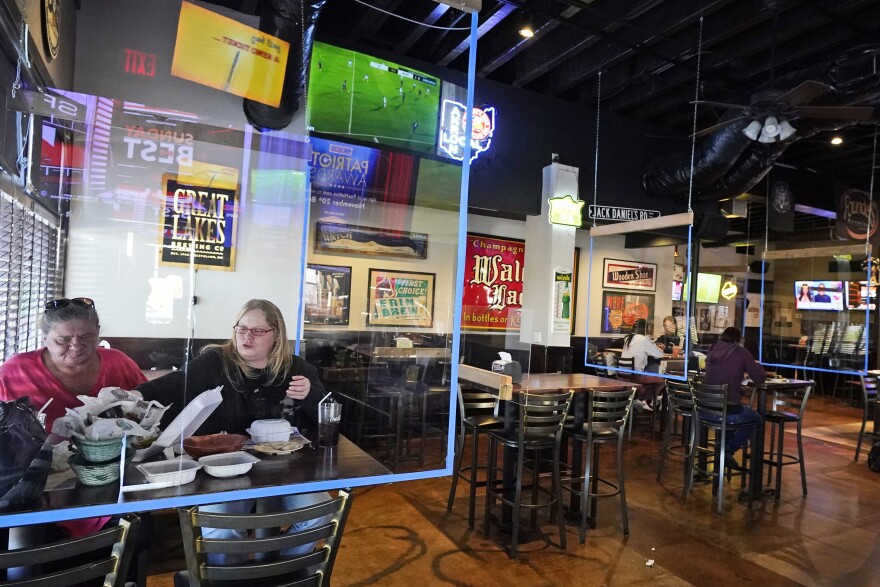To combat the state's renewed surge of coronavirus cases, Ohio is issuing a curfew that requires most retail establishments to close from 10 p.m.-5 a.m.
Gov. Mike DeWine says the curfew will take effect Thursday, Nov. 19 and last for 21 days, after which point the order will be re-evaluated.
“The bad news is that our situation in Ohio is deteriorating,” DeWine said at a press conference Tuesday. “We see more and more cases, more and more people in the hospital. We've got to turn this thing around.”
The curfew order, which has yet to be released, does contain exemptions for groceries and pharmacies. While it forbids dining inside restaurants after 10 p.m., it allows takeout, delivery and drive-thrus to continue during that period.
DeWine also said the curfew does not apply to people who need to go to work or travel for emergency purposes, like going to the hospital.
"Our idea is to carve this time out," DeWine said. "That in and of itself will reduce our contacts."
Violating the order is a 2nd degree misdemeanor, which carries a penalty of up to $750 or 90 days in jail, but it's not clear how exactly the curfew will be enforced. DeWine said he doesn't expect law enforcement to pull people over for being out after 10 p.m., but it gives them a tool with which to confront people gathering in groups.
DeWine last week announced a new unit with the Ohio Bureau of Workers Compensation that will enforce coronavirus restrictions at retail establishments, and possibly shut down businesses that refuse to comply.
"Just A Slowdown"
The overall goal of the curfew, DeWine says, is to reduce the number of contacts that people have – possibly by up to 25%.
"If you can slow these contacts down, that's going to go a long way to slow this virus down," the governor said. "This virus lives only when it goes from one person to another."
Lt. Gov. Jon Husted said they consider a curfew the "least disruptive" option for the state's economy, but will have the "most meaningful impact" for hospitals, which have been struggling with space and staffing amid an influx of COVID-19 patients.
"We don't need a shut down, but we do need to slow down for a few weeks to get this virus back into a manageable situation," Husted said, reiterating DeWine's own recent comments.
Currently, Ohio has 3,648 people hospitalized for COVID-19, along with 897 people in the ICU and 441 people on ventilators.
John Parker, president and CEO of the Ohio Restaurant Association, says the organization's board of directors support the curfew. He emphasized that most restaurants are complying and even exceeding the state's coronavirus guidelines, while dealing with heightened costs and far lower sales than normal.
"We think it's the right step at the right time," Barker said. "It's going to let Ohioans to do their part without having what we thought would be an immediate and disastrous effect on restaurants and thousands of employees."
DeWine last week floated the idea of closing bars and restaurants again if the COVID-19 surge continued, but said he heard a flood of opposition from workers and owners.
"We think we can accomplish a lot more, frankly, by having this curfew than closing one or two sectors," DeWine said.
Back in July, the Ohio Liquor Control Commission passed a rule banning the sale of alcohol after 10 p.m., and requiring patrons to finish their drinks by 11 p.m. Now, those establishments will have to shut down entirely at 10 p.m.
Alarming Numbers
The Ohio Department of Health on Tuesday reported 7,079 new cases, a slight dip from recent highs but still one of the biggest daily increases since the pandemic began. Ohio also logged 30 more deaths, bringing the state's total coronavirus death toll to 5,772.
Pointing to Ohio's hospitalization numbers, DeWine said "our situation in Ohio is deteriorating." On October 13, the state had 1,000 patients with COVID-19 in hospitals. By November 5, that number had doubled to 2,000, and then increased to 3,000 just a week later.
"A dramatic, dramatic change," DeWine said.
On Monday, DeWine reissued a public health order limiting most gatherings to 10 people or fewer. While the order does not restrict wedding ceremonies or funerals, which DeWine and health experts say are where many COVID-19 cases are traced to, it does subject those events to the same rules on face masks and social distancing as restaurants.
DeWine also called on Ohioans to limit their outside contact to one person per day, and make safer choices for themselves and others – including avoiding parties, wearing face masks to chuch or other gatherings, and planning out store trips to reduce exposure.
"Ask what you can do for your fellow man," DeWine implored. "Ask what you can do for the people of Ohio. We are all in this together, and what each one of us does will make a difference."
However, the recent wave of restrictions have spurred protests from many conservative groups and lawmakers, who have repeatedly tried to limit the Health Department's ability to issue or enforce business restrictions.
On Monday night, close to 50 people held a "Lighted Dance Party" in front of the governor's Cedarville mansion in protest against the mass gathering order, which bans dancing at wedding receptions. Almost none of the protesters wore masks.
This is a breaking story and will be updated as more information develops.







